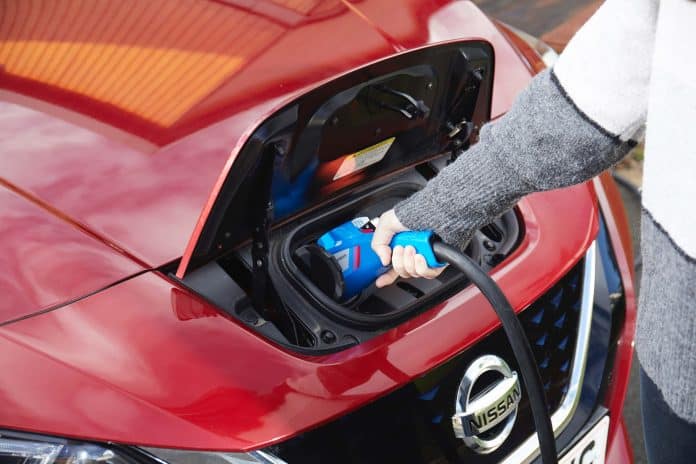Electric vehicles (EVs) are often seen as a problem in relation to increasing demand on electricity networks, but distribution network operator Western Power Distribution (WPD) instead sees EVs as a solution, and is demonstrating why this is the case through its Electric Nation Vehicle to Grid (V2G) project.
In partnership with CrowdCharge, WPD’s Electric Nation project is recruiting 100 Nissan EV owners in the Midlands, South West England and South Wales to take part in the trial of V2G smart charging technology.
Roger Hey, WPD’s DSO Systems and Projects Manager, trialled V2G charging before EV drivers were invited to take part in the Electric Nation project, and, although an electrical engineer himself, he was amazed to see how much energy an EV battery could store.
Roger comments: “One of the latest Nissan LEAFs with a 62 kWh battery would be able to put energy back into the grid that would be the equivalent of powering a house for days. Multiply this by millions of EVs across the UK and there is the potential for huge storage which can mitigate the peaks in electricity demand. And people could be rewarded for offering their EVs as a service to the grid.”
Roger sees V2G as a huge opportunity to reduce the extent, and therefore the cost, of upgrades to the electricity network and the building of new electricity generation.
Currently, only Nissan EVs can be used for V2G charging due to their CHAdeMO technology. The majority of EVs have the CCS charging system, which is due to be V2G compatible by 2025. From that point V2G should be possible for all EVs.
In the meantime WPD is involved in a range of innovation projects to explore other ways of ensuring there is sufficient capacity in the electricity network for the increasing numbers of EVs well ahead of time.
WPD has a sophisticated system to constantly forecast the growth of EVs – not just on a national level, but down to individual postcodes. Currently serving around 9 million customers, the network operator predicts that there may be up to 3 million EVs in its area by 2030, with 217,000 chargers connected to the network by 2023.
A tool has also been created by WPD and EA Technology which will assess the impact of EVs on local low voltage (LV) networks. Developed as part of the original Electric Nation smart charging project, this shows where networks are becoming constrained as a result of local clusters of EVs, and will help to highlight where proactive reinforcement can help to avoid network constraints, in particular due to EV connections.
WPD is working with a wide range of organisations including local authorities, house builders and fuel station operators to facilitate the installation of more charge points, including at EV filling stations/charging hubs, and through on-street charging solutions for the 40% of homes that don’t have off-street parking.
For those who can charge at home, a project in Wales is feeding higher capacity three-phase electricity to domestic properties. Although homes already have three-phase electricity in Germany and Norway, in the UK this is typically only the case at commercial premises.
The Electric Nation Vehicle to Grid project is offering the free installation of V2G smart chargers worth £5,500 to Nissan EV drivers who live in the Midlands, South West and South Wales. CrowdCharge is recruiting 100 people for the trial to help Distribution Network Operators (DNOs) and others to understand how V2G charging could work with their electricity networks. Over 300 EV drivers have applied to join Electric Nation so far, however recruitment remains open to ensure the project secures 100 participants that meet all the eligibility criteria.
Electric Nation is different to other V2G projects because it is using up to five different energy suppliers instead of just one. This means that the trial is a more realistic simulation of a future world in which many streets will have a number of EVs using V2G chargers operated by different energy suppliers.
In the Electric Nation V2G trial, each supplier will use their charger groups to test their various energy services utilising CrowdCharge’s demand management platform, which provides optimised charging sessions.
The V2G trial follows the first Electric Nation project from 2018/19 which at the time was the world’s largest EV smart charging trial, providing real life insight into people’s habits when charging their vehicle. The trial provided data from more than two million hours of car charging, revealing the user habits on timings of charge, where and for how long, as well as the impact of different tariffs.
By plugging in at specified times and putting energy back into the grid, active participants of the Electric Nation Vehicle to Grid project are expected to earn a minimum reward up to the monetary value of £120, available over the one-year trial period from March 2021 to March 2022.
Trial applicants:
- Must be resident in the Western Power Distribution (WPD) licence area (Midlands, South West and South Wales)
- Must have a Nissan EV with a battery capacity of at least 30kWh or more
- Need to have the vehicle until the end of the trial (March 2022)
- Need to have off-road parking
- Will use the CrowdCharge mobile app to manage charging
- May need to switch to a new energy tariff if required by their assigned project energy supplier
- May need to have a new smart meter put in/updated as part of the project participation.
Although the application process for the Electric Nation Vehicle to Grid project is open, the timescale for charger installations is subject to confirmation based on government advice in relation to COVID-19.
For more information and to apply to join the project visit www.electricnation.org.uk




